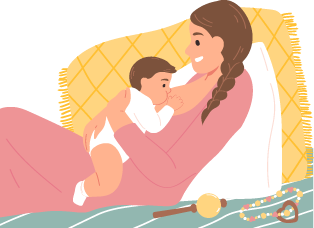Breast Milk
Breastfeeding has health benefits for both babies and mothers. Breast milk provides a baby with ideal nutrition, and supports growth and development. Breastfeeding can also help protect the baby and mom against certain illnesses and diseasesFive great benefits of breastfeeding:
As the baby grows, the mother’s breast milk will change to meet her baby’s nutritional needs.
Breastfed babies have a lower risk of asthma, obesity, type 1 diabetes, and Sudden Infant Death Syndrome (SIDS). Breastfed babies are also less likely to have ear infections and stomach bugs.
These antibodies help babies develop a strong immune system and protect them from illnesses.
Mothers can feed their babies on the go without worrying about having to mix formula or prepare bottles. When traveling, breastfeeding can also provide a source of comfort for babies whose normal routine is disrupted.
Breastfeeding has health benefits for the mother too! Some cancers, type 2 diabetes, and high blood pressure are less common among women who breastfeed.
What is colostrum?
Colostrum is the first milk your body produces during Pregnancy. It forms in your mammary glands (breasts) and plays an important role in building your baby’s immune system. If you plan on breastfeeding, it’s the first milk your baby will get from your breasts. it’s high in protein, vitamins, minerals, and immunoglobulins (antibodies) that help build your baby’s immune system. It’s often called “liquid gold” because of its rich, golden color and valuable benefits.
What is colostrum made of?
Colostrum is high in protein and low in fat and sugar. It’s filled with white blood cells that produce antibodies. These antibodies strengthen your baby’s immune system, protecting him or her from infection. Colostrum is highly concentrated and nutrient-dense even in tiny doses, so your baby’s tummy doesn’t need a lot to reap its benefits.

What kind of nutrients are in colostrum?
Colostrum is rich in nutrients that protect and nourish your baby unlike anything else. It’s made up of things like:
- Bioactive factors present in human milk (an antibody to protect against infection)
- Lactoferrin (a certain type of protein) helps prevent infection
- Leukocytes (white blood cells) help in developing the immune system
Colostrum is rich in magnesium, which supports your baby’s heart and bones, and copper and zinc, which also support immunity.
How to Breastfeed
Breastfeeding your baby is a unique experience. It is important to follow the doctor’s recommendations, which will be a personalized tracking of your situation and particular needs, There are lots of different positions you can use to breastfeed. You can try different ones to find out what works best for you. You just need to check the following points:
- Are you comfortable? It’s worth getting comfortable before a feed. Use pillows or cushions if necessary. Your shoulders and arms should be relaxed.
- Are your baby’s head and body in a straight line? It’s hard for your baby to swallow if their head and neck are twisted.
- Are you holding your baby close to you, facing your breast? Supporting their neck, shoulders, and back should allow them to tilt their head back and swallow easily.
- Always bring your baby to the breast and let them latch themselves. Avoid leaning your breast forward into your baby’s mouth, as this can lead to poor attachment.
- Your baby needs to get a big mouthful of breasts. Placing your baby’s nose at the level of your nipple will support your baby’s mouth to attach to the breast.
- Try not to hold the back of your baby’s head, so that they can tip their head back. This way your nipple goes past the hard roof of their mouth and ends up at the back of their mouth against the soft palate.
Breastfeeding positions
Before you breastfeed your baby, have a drink beside you – something thirst-quenching like a big glass of water. There are a few different breastfeeding positions you can try;
These are 4 of the most popular:
Cradle hold
This is probably the most popular breastfeeding position. However, if you’ve had A cesarean, this may be uncomfortable as your baby lies across your tummy near the scar (try lying on your side or the rugby hold instead). For the cradle hold, sit in a comfy chair with armrests, or a bed with cushions or pillows around you.
- Lie your baby across your lap, facing you.
- Place your baby’s head on your forearm – nose towards your nipple. Your hand should support the length of your body.
- Place your baby’s lower arm under yours.
- Check to make sure your baby’s ear, shoulder, and hip are in a straight line.
Here is a top tip…
If you’re sitting on a chair, rest your feet on a small table – this will stop you from leaning forward which can make your back ache.


Rugby hold
The rugby hold is a good position for twins as you can feed them at the same time, as well as Cesarean babies as there’s no pressure on the tummy and scar area.
- Sit in a chair with a cushion or pillow along your side.
- Position your baby at your side (the side you want to feed from), under your arm, with their hips close to your hips.
- Your baby’s nose should be level with your nipple.
- Support your baby’s neck with the palm of your hand.
- Gently guide them to your nipple
Lying on your side
This is a good position if you’ve had a cesarean or difficult delivery, or if you’re breastfeeding in the middle of the night.
- Start by getting comfy lying on your side. Your baby lies facing you, so you are tummy to tummy. Check to make sure your baby’s ear, shoulder, and hip are in a straight line – not twisted.
- Put some cushions or pillows behind you for support. A rolled-up baby blanket placed behind your baby will help support them – remember to remove it after you have finished feeding. If you’ve got a pillow under your head, make sure it’s not too close to your baby’s head or face.
- Tuck the arm you’re lying on under your head or pillow (ensuring your baby’s position isn’t altered by the pillow) and use your free arm to support and guide your baby’s head to your breast.


Laid-back nursing
Laid-back breastfeeding, also known as “biological nursing”, is when you lie back in a comfortable semi-reclined position on a comfy sofa or bed. If you have had a cesarean section (c-section), your baby can lie across you and away from your incision- Lean back (but not flat) on a sofa or bed.
- Prop yourself up with cushions or pillows so your back, shoulders, and neck feel supported.
- When you are comfortable, place your baby on your front. Their tummy should be resting on your tummy – but if this is uncomfortable, lie them to one side.
- Make sure you are upright enough to look into your baby’s eyes
- While supporting your baby, gently guide your baby to your nipple.